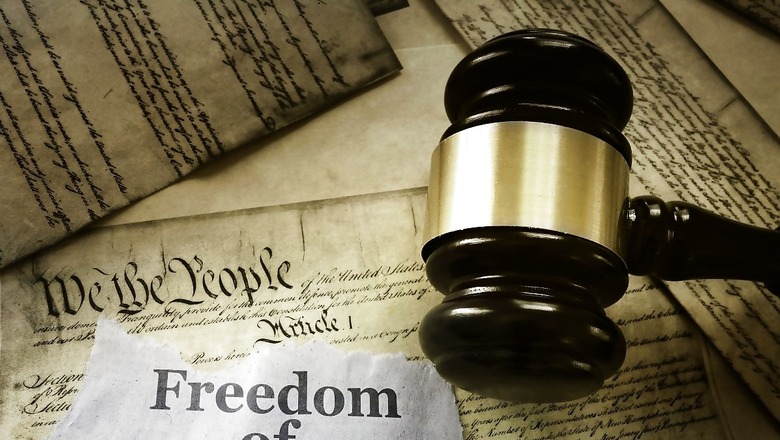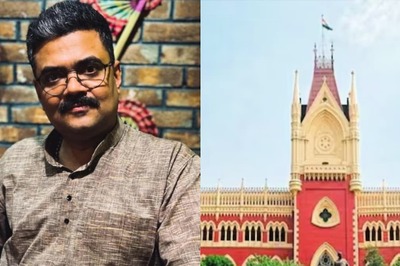
views
Case 1: It was an unusually busy and buzzy day in the otherwise sleepy village of Undhela in Gujarat’s Kheda district. Ten young Muslim men were brought to the chowk by police and each one was held against a pillar and caned by policemen in plain clothes. As the video shows, the villagers shouted “Bharat Mata ki Jai”, while the caning continued. Some others were seen cheering and clapping. These 10 men were among 43 who allegedly threw stones, indulged in violence and disrupted a garba event at the same chowk the previous night.
Case 2: At a store in Citrus Springs in Florida, USA, Roy and Robert Lashley met a black man, who too was shopping there. Seeing an Afro-American man, Roy repeatedly used racial slurs. Later the two followed the victim into the parking lot. There, Robert ran to the victim and hit him several times, while Roy retrieved an axe handle from his truck, ran to the scene, and struck the victim multiple times with it. The victim sustained deep injuries to his face and legs.
There are numerous such cases in the US of targeted killings in the name of religion and colour. In one case, in January this very year, a Black man was seen screaming for his mother as US cops beat him to death, reminding one of the killing of George Floyd in 2020 that led to the nationwide ‘Black Lives Matter’ movement. Statistically speaking, this year, the trend of fatal police shootings in the United States seems to be only increasing, with a total 344 civilians having been shot, 42 of whom were Black (as of 1 May 2023). In 2022, there were 1,096 fatal police shootings, of them more than one-fifth (225) were connected with Black. In 2021, there were 1,048 fatal shootings — and 233 of them came from the Black background.
When one analyses the two given cases, they appear similar in nature — of police brutality, of targeting a particular community (religious or racial). In fact, in the first case, the victim has been at least accused of throwing stones, indulging in violence and disrupting a garba event. But in the second case, there was no such provocation; it was sheer racial hatred that led to the targeting of that Black man. But the State Department’s Religious Freedom Report 2022, released by US Secretary of State Anthony Blinken in Washington on Monday, has picked out Case 1, among other isolated incidents in India, to project the image of a majoritarian state indulging in targeted attacks against “members of religious minorities”. As for the violence in America, they remain law and order issues.
Apart from the selected targeting of Muslims, the report also highlights how religious conversion in India is under state scrutiny. “Thirteen of 28 states have laws restricting religious conversions for all faiths. Some of these states also impose penalties specifically against forced religious conversions for the purpose of marriage although historically, some state high courts have dismissed cases brought under these laws,” it said.
What this report doesn’t say is that the laws in these states are reactive in nature; they have been made after several cases of “undue influence, coercion, and allurement” came to light. As Section 3 of Uttar Pradesh’s Prohibition of Unlawful Conversion of Religion Act, 2021 says, “No person shall convert or attempt to convert” another individual, directly or otherwise, by “misrepresentation, force, undue influence, coercion, allurement or by any fraudulent means”. It is only in the case of “violations of Section 3” that one is punished “by prison terms between one and five years and a fine of at least Rs 15,000”. One wonders how a law that stops “undue influence, coercion, allurement or by any fraudulent means” can be cited to paint India and its democracy in dark hues.
The Religious Freedom Report 2022, however, is not one of its kind in targeting India and its leadership. In fact, in the last year, especially after the Ukraine war and with India heading for a parliamentary election early next year, the anti-India, anti-Modi tirade has only increased. The United States Commission on International Religious Freedom (USCIRF), for instance, had come up with its report in March this year and it too had targeted India for promulgating the anti-conversion laws. It accused the “12 Indian states” of promulgating the anti-conversion laws that “grossly violated” the Universal Declaration of Human Rights and the International Covenant on Civil and Political Rights.
But it was the report of the US Holocaust Museum that took the cake. This report came out in December last year and its Early Warning Project for 2022-23 has ranked India eighth in the top 15 highest-risk countries in the world. “Our statistical model estimates that there is a 7.4 percent, or approximately 1 in 14, chance of a new mass killing beginning in India in 2022 or 2023. India ranks 8th highest-risk among 162 countries,” the report said. For the last six years, India has ranked in the top 15 highest-risk countries in the world. Interestingly, as per the latest report, India is just better off than Afghanistan, but worse than Sudan, Somalia, Syria and Iraq in the same ascending order. Even autocratic China, ranked 23rd in the list, is better off than democratic India!
The Western doublespeak is obvious when one realises that Black Americans make up 13 percent of the US population “but are killed by police at more than twice the rate of white Americans”, as the Washington Post had reported. Still, the Americans never shy off from lecturing the world’s largest democracy with a content-size population and globe-like diversity. Europeans have experienced a surge in government restrictions on religious activity over the last decade, as per a recent PEW survey, but they remain the paragon of libertarian values.
Pallavi Aiyar writes in Punjabi Parmesan: Dispatches from a Europe in Crisis, “The laws passed across Europe aimed at restricting the public performance of Muslim belief are rarely in proportion to the reality of the Muslim presence. A 2009 Swiss ban on minarets was carried out despite the existence of a sum total of four minarets in the entire country; while the French interior ministry estimates that less than 1 percent of Muslim girls wore headscarves to schools before they were banned. The number of women who chose to wear burqas in the country before they were outlawed was around 350, a fourth of whom were converts.”
Still, when an Indian educational institution in Karnataka — and not the Government of India — decides to enforce its dress code in the classroom, all hell breaks loose. Indian democracy, secularism and liberalism — all seem to be imperiled. But the West comes out unscathed even for the worst of crimes. This was also evident during the so-called farmers’ protest in India, when the West joined in chorus to go soft with the protesters, but while dealing with their own protesters, they took the most undemocratic measures available to them.
The political nature of the Religious Freedom Report 2022 is obvious when it talks about the 26 April letter by, 108 former senior government officials, who “wrote Prime Minister Narendra Modi stating that government discrimination against religious minorities, ‘particularly Muslims, in states like Assam, Delhi, Gujarat, Haryana, Karnataka, Madhya Pradesh, Uttar Pradesh and Uttarakhand’, was ‘undermining’ the country’s Constitution. But what about the open letter written by eight former judges, 97 ex-bureaucrats, and 92 former armed forces in support of the current dispensation in India?
The timing of the Religious Freedom Report 2022 is interesting, as it comes ahead of Prime Minister Modi’s first official state visit to the US. The US-led West wants India by its side, as has been obvious during the ongoing Ukraine crisis, but it is vehemently opposed to the idea of a strong and powerful India. It wants an ally against rising China, but more in the mould of Ukraine, whose leadership has taken the self-destructive path while pushing the Western interest in Kiev. To its misfortune, India isn’t Ukraine. And Modi definitely isn’t Zelenskyy. And that’s where such anti-India reports become relevant: To tarnish the image of India and its political leadership, and push for a regime change in 2024 — a government that it hopes will be more pliant to Western interest and prone to American pressure.
The author is Opinion Editor, Firstpost and News18. He tweets from @Utpal_Kumar1. Views expressed are personal.



















Comments
0 comment